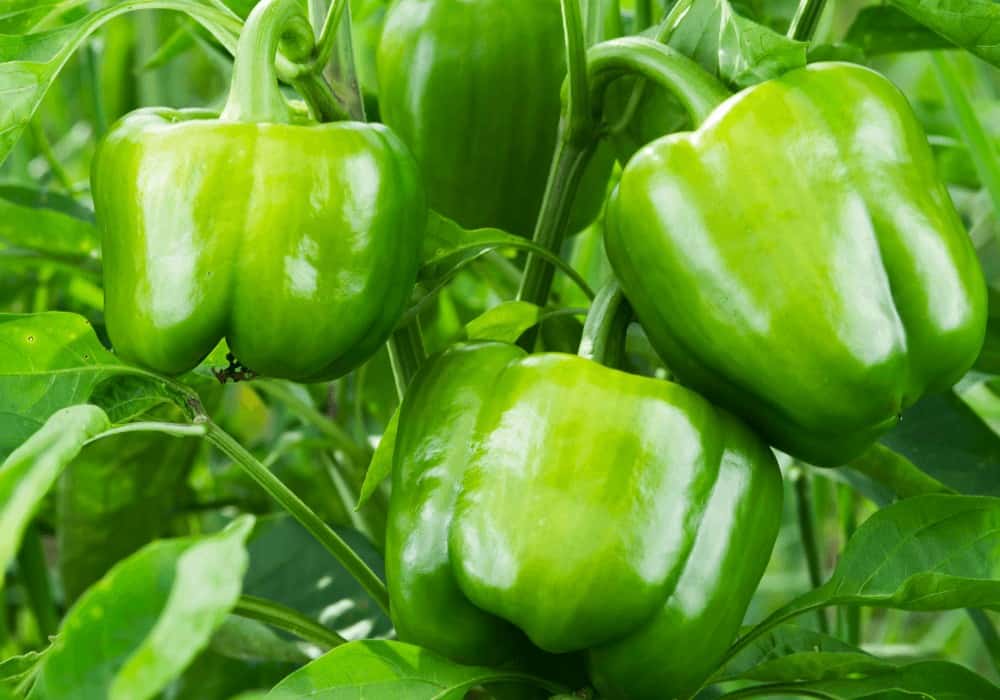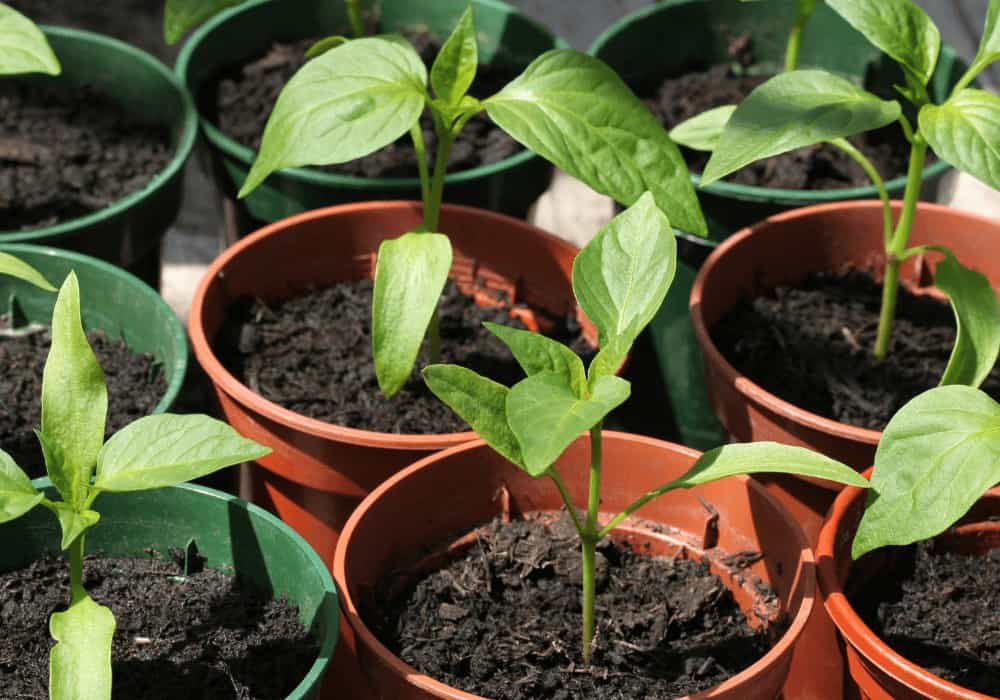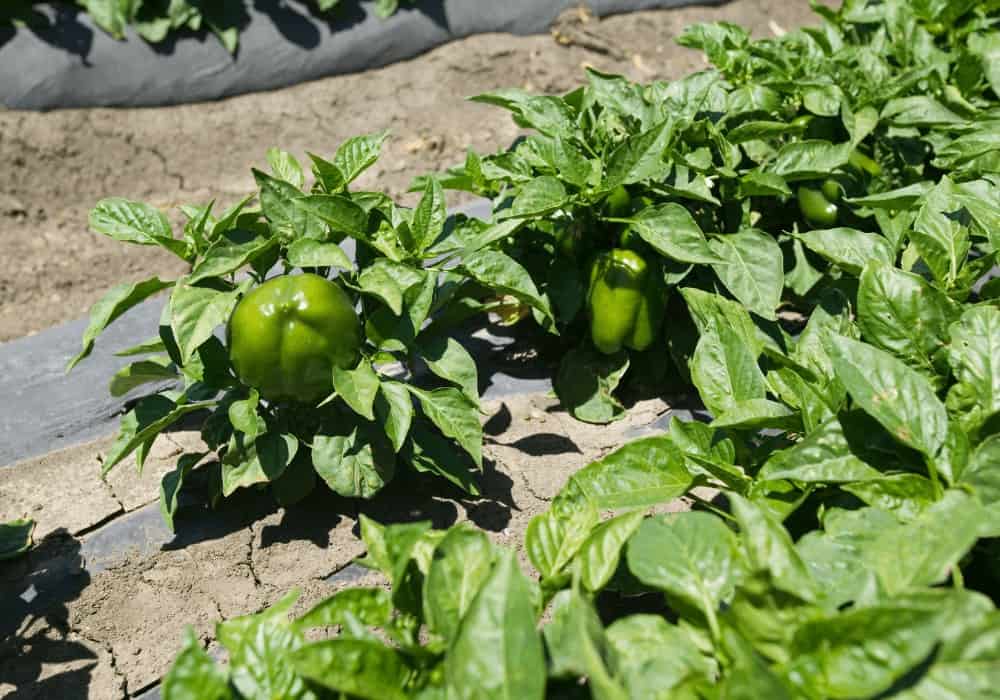Bell peppers are one of the best and easiest types of pepper plants to grow in your home as it requires less care and maintenance. So, if you’ve got some pepper scraps, we’d advise you don’t throw them away as you’re about to learn how to grow bell peppers from scraps.
But can you grow bell peppers from scraps? The short answer is YES! You can literally take some of those tiny bell pepper scraps, dry them, and raise them into flourishing, productive pepper plants.
However, you cannot do this on your own if you don’t have any experience and knowledge of how to works – and that’s precisely what we’re going to teach you today.
Let’s get started!
Table of Contents
What Is A Bell Pepper?
Bell peppers are perennial plants, which can be grown from seeds or transplantation. When bell pepper seeds sprout and grow 2 to 3 true leaves, you can transfer them into a big container.
This type of pepper is famously used in many homes as a spicy vegetable for different dishes. Its skin is clear, fresh, and crispy with a smooth outer cover, and it is also hollow with a bunch of seeds hanging in the center.
Bell peppers thrive best in warm environments and well-drained, adequately aerated, and nutrient-rich loamy soil.
As for the required temperature, bell peppers flourish well in temperature between 20 to 30 degrees Celsius. The most interesting thing about this pepper is that it’s insanely easy to grow; hence, it requires a small investment and maintenance.
Can You Grow Bell Peppers From Scraps?

Yes, just like many plants such as broccoli, red onions, zucchini, cauliflower, and rutabaga, bell peppers can also be grown from scraps, and the process is somewhat seamless.
Although the quality might not be the same when compared to bell peppers grown from seed, if the peppers' scraps are cultivated from heirloom or open-pollinated peppers seeds, you can grow bell peppers that will be pretty much similar to parents in quality.
Why You Should Grow Bell Peppers from Scraps
There are several reasons why you should consider growing bell peppers from scraps, and some of these reasons are:
1. The steps are few and easy
Growing bell peppers from scraps only take a few steps and efforts, which you will learn more about later in the article.
Aside from that, the pepper can also be propagated indoors, and it requires only a small garden or any of your desired gardening systems for it.
2. It is a great gardening activity
Utilize pepper scraps for gardening purposes is a wonderful activity that will teach you the importance of consuming fresh produce.
This activity can also be done at home at your own pace, giving you a sense of empowerment.
3. Reduces waste
Most gardeners desire to build a future where people know how important it is to eat healthy food and understand its origin.
Now, growing plants with scraps, reducing waste, and saving money on food are all among the benefits of this vision.
4. It’s an easy entry into gardening
As a gardener, I bet you know and agree that gardening and a super fun activity.
When growing peppers, there are several things to be considered, including deciding on the type of seed to buy, kind of soil to use, amount of sun and water required by the plant, the amount of space needed, as well as the temperature and humidity.
Interestingly, most of these factors will not come into play when it comes to growing capsicum from scraps, as you won’t be buying new seeds, and they can be propagated indoors hydroponically.
How to Grow Bell Peppers From Scraps

Now that you already know why you should grow bell peppers from scraps let’s quickly look at how to grow bell peppers from scraps the easiest possible way!
1. Pick overripe bell pepper
Bell pepper scraps will usually be gotten from leftovers. It’s worth mentioning that the scraps you will grow should be from bell peppers that are matured and overripe.
This is simply because overripe fruits usually have natural seeds and deliver the best results.
2. Remove the seeds
Cut open the bell peppers using a small knife and remove their seeds, then spread them on a clean tray, keeping them under the sun.
If you don’t have a clean tray that you can use to spread them, a paper towel is also a good alternative.
3. Leave the seeds under the sun
Now that the tray or paper towel is already placed under the sun let them sit for about 2 days so they will dry completely.
You don’t want to leave the seeds under the sun for an extended period as that can make them lose viability. So, they shouldn’t stay under the sun for more than 2 days.
You can also dry the bell pepper seeds by placing them under a shade or a fan. Either way, ensure they dry normally.
4. Get a pot and prepare the potting mix
Once the seeds have dried, the next step is to get a pot and fill it with a high-quality potting mix – and then spread the bell pepper seeds on the soil.
Use a thin layer of potting mix to cover the seeds, making sure that the seeds are not buried too deep. Now, use your hands and press the potting mix gently.
5. Water the seeds
The next step is to water your seeds so they can adjust to the new environment. While doing this, you want to avoid overwatering the seeds. You also want to ensure that the soil is moist – and not soggy.
You can examine the soil moisture using a moisture meter or use your finger if you don’t have any.
6. Keep the pot in partial shade
Once you’ve followed all the previous steps, the next thing is to leave the pot in partial shade and keep a close eye on it.
Your seeds will start germinating after 5 to 6 days of planting them. And after 10 days, your seedlings will be tall enough – and will be ready for transplanting within one month.
7. Harden off the plant
While bell pepper seedlings will sprout and ready for transplanting after about 1 to 4 weeks of germination, they are often prone to transplant shock.
The best way to prevent this shock is to gently introduce the seedlings to the outside environment for a few hours daily; you can also increase the time gradually as time goes on.
This will help them adapt better, hence preventing stunted growth and leading to strong and healthy bell pepper plants. This process should be carried out about two weeks before the transplant.
8. Transplant your seedlings outdoors
You can transplant your seedlings to garden soil after they’ve developed at least 4 true leaves. You want to make sure that the soil temperature is between 65-to-75-degree Fahrenheit.
Finally, your bell pepper seedlings should be planted 12 to 24-inches apart from each other and in well-drained garden soil. Additionally, make sure that their root balls are adequately covered.
How To Care For Bell Peppers

Now that your capsicum is already growing from scraps, let’s now look at how to care for bell peppers for healthy growth.
1. Proper mulching
When left on the soil, weeds can suck essential nutrients from the soil, leaving your bell pepper plants little to no nutrients and water to survive on.
Now, this is where mulching comes into play. It helps to reduce these unwanted weeds from the soil by suffocating them. Aside from that, mulching also helps keep the soil warm so the bell peppers can grow without issues.
2. Sunlight requirement
Most edible plants need enough sunlight to survive, so it’s essential to choose an area in your vegetable garden where your bell pepper plants can enjoy full sunlight; this will also help them ripen properly.
Just be mindful of the location you choose for the plant, especially if you live in a climate that is prone to high heat and severe sunlight.
Bell peppers thrive best in warm weather, but extremely high heat is not suitable for the plant.
3. Be careful with watering
Bell pepper plants need deep watering (about 1 to 2 inches) to flourish. But if you live in a high hot climate environment, water the peppers more often.
Just ensure you don’t overdo it because overwatering, as well as dryness, are not suitable for capsicum plants.
Overwatering can suffocate the plant’s roots, and if the soil is dry, it can lead to bitter tasting. Therefore, continuously monitor the soil so you will know when and how often to water the plant.
4. Fertilizer requirement
A balanced fertilizer generally works for bell peppers. However, if you notice that you have enough phosphorus after testing your soil, go for a low- or no-phosphorous fertilizer.
Miracle-Gro Continuous Release Plant Food and Dr. Earth Organic Vegetable & Herb Fertilizer are among the best fertilizers for bell pepper.
Nitrogen is pretty much essential for stimulating good bell pepper growth; however, you must know the best time to fertilize bell peppers to achieve the best results.
5. Stake your plant
Staking your bell pepper plants will help them to keep upright and protected. Pepper plants will also get away from pests, and sunscald will be minimized if they get proper support.
Apart from all that, staking will also make harvesting pretty much easier, and your pepper plants will get proper air circulation.
6. Pay attention to pests
Pests such as flea beetles and aphids can be incredibly harmful to bell pepper plants. You can fight these little monsters with good insect killers for vegetable garden.
You can also use vinegar to get rid of aphids. Keep an eye on your plants to keep the invasion of insects under control.
7. Soil type
As I mentioned earlier, bell peppers thrive best in well-drained soil, so choose sandy or loamy soil for the plant – and the soil’s pH must be between 6.0 to 6.8.
How to Store Bell Peppers the Right Way

You can keep the bell peppers in the refrigerator for about 10 days after harvesting them. Ensure to keep them in a plastic bag before putting them in the refrigerator.
Alternatively, you can dry the bell peppers and store them for future use. You will need a conventional oven for this.
Here’s how to dry your bell peppers:
- Wash the peppers properly to get rid of every form of dirt, and then seed them
- Cut the peppers into one-half-inch strips
- Steam the strips for 10 minutes and then spread them on a baking sheet
- Set the conventional oven at its lowest temperature and use it to dry the bell peppers
- Put the bell peppers in the bag storage containers when they are cool
And that’s it!
Frequently Asked Questions
How long do bell peppers take to germinate?
Bell pepper seeds generally germinate within 7 to 21 days once they’re kept in a nice and warm temperature at 80 to 90˚ F. They need this temperature range to ensure the best germination.
Are bell peppers easy to grow?
Yes, bell peppers are easy to grow; however, the most critical factor that might affect their growth is temperature. Caring for pepper plant in its early stages is often critical.
How many bell peppers does a plant produce?
Basically, one bell pepper plant will likely produce at least 20 peppers in a period of 3 months.
Can you grow bell peppers from store-bought peppers?
Yes, bell peppers can be grown from store-bought peppers – and the process is almost the same with growing them from scraps:
- Buy the bell peppers
- Cut them open using a small knife
- Take out the seeds
- Dry them by placing them under the sun for about an hour
- Follow the steps outlined above to grow them
Why do some bell peppers have three bumps?
There are male and female varieties of bell peppers. The variety with a 3-bump is a male bell pepper – and it grows a bit quicker and usually has fewer seeds inside.
The 4-bump variety is a female bell pepper. It is slower to grow and has more internal seeds.
Are bell peppers perennial?
Yes, bell peppers are tropical perennials plants!
What color bell pepper is the healthiest?
Every bell pepper starts out green initially, and they’re all a fantastic source of vitamin C and beta-carotene.
However, red bell peppers are the healthiest in terms of nutrients, and this is because it stays on the plant the longest.
How long does it take bell peppers to produce fruit?
It takes a bell pepper plant anywhere from 2-3 months to produce fruit, depending on the color variety you’ve planted.
Green bell peppers take the shortest period of time to produce fruit, while red bell peppers stay on the plant longer to mature.
Why are my bell peppers so small?
If your peppers are so small, it’s probably because they’re not getting enough water, although climate or the way you planted the peppers can also affect their size.
How much sun do bell peppers need?
Bell pepper plants generally need about 6 to 8 hours of sunlight daily.
How long does it take to grow bell peppers from seed?
Sweet bell peppers have a long growing season and can take anywhere from 60 to 90 days from planting the seeds to harvesting. Sow your bell pepper seeds at least 8 to 10 weeks before your last spring frost date.
How much room do bell peppers need to grow?
Space bell peppers at about 18 inches (46 cm) between the plants. While bell pepper plants are often slim, the root systems can be somewhat large, requiring more space to grow.
Do you need a trellis for bell peppers?
Yes, but that depends. Staking bell pepper plants is often an excellent idea, as we mentioned earlier.
While many pepper plants are vigorous and do an excellent job at holding themselves upright, they need a little help sometimes, especially toward the end of the growing season.
Conclusion | How To Grow Capsicum From Scraps
Hopefully, you’ve now mastered how to grow bell peppers from scraps. As you can see, the steps are pretty much easy and straightforward.
Peppers are generally easy to grow once you know their primary requirements. Whether you want to grow bell peppers from seeds, scraps, or store-bought, the steps are relatively the same.
Just make sure you plant them in the right potting mix, do not expose them to too much heat, protect them from diseases and pests, and you will soon enjoy a bountiful bell pepper harvest.




